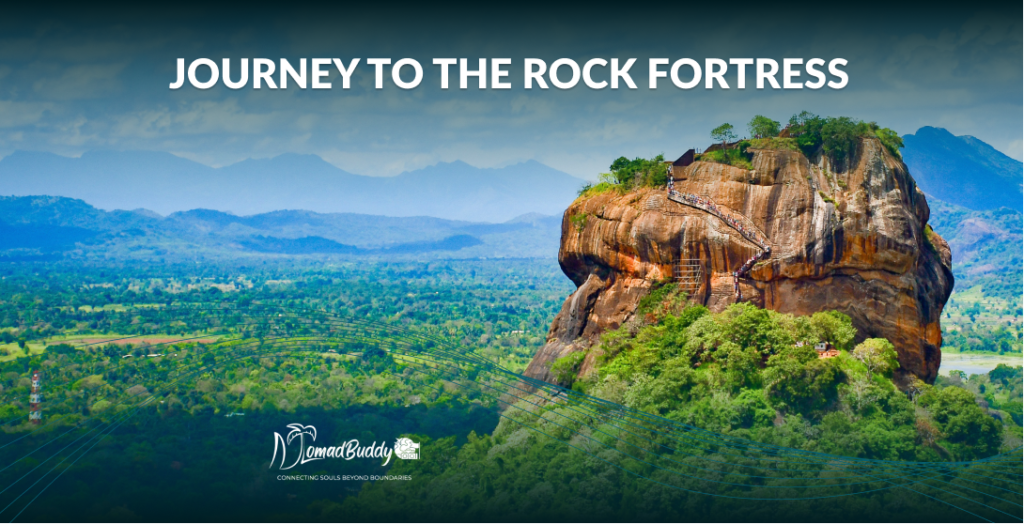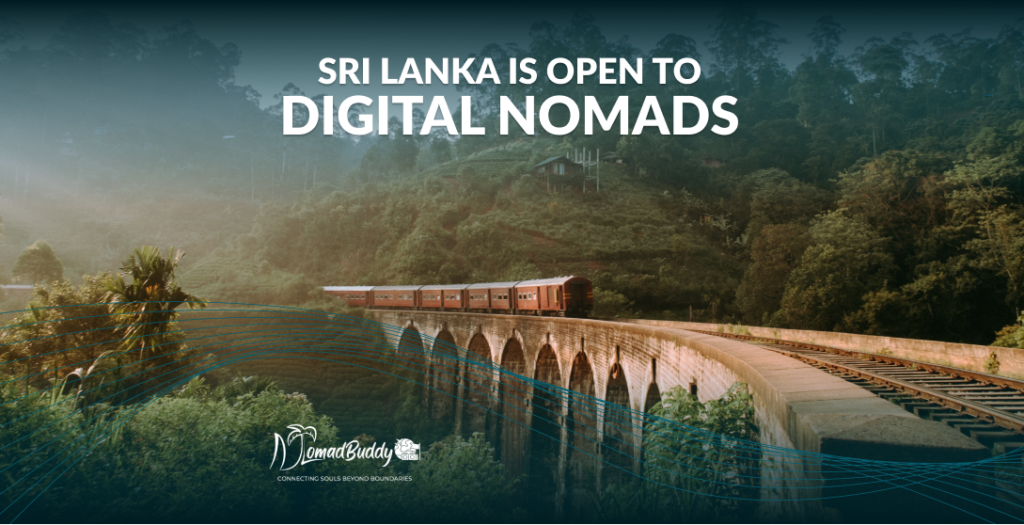Let's go inside
Sigiriya Rock, which emerges from the middle plains of Sri Lanka’s jungle, is a really spectacular site to see.
Further inside.....
This 200-meter sheer rock that rises above a largely flat landscape and is frequently engulfed in a misty haze that casts a mysterious veil over it is frequently referred to as the eighth wonder of the world.
Given that it is both a geological wonder that is billions of years old and the location of an ancient castle and fortification built in the fifth century by a rapacious King, it truly is a wonder.
As it is now known, Lion Rock is rich with human myth and legend about Kings and monks, victories and losses, and the historical significance of Buddhism to the region.
A trip to Sigiriya (and the nearby Pidurangala) is essential for those who want to comprehend Sri Lanka’s cultural core.
Sigiriya opening hours
The Sigiriya ticket office is open from 06:30 am to 05.30 pm every day and is situated on a side street near to the main fortress entrance. Don’t make the mistake of starting up the stairs without one, or you’ll have to turn around and retrace your steps to get one! It’s easy to miss, so make sure you visit this first to buy your tickets before you make your way inside the complex.
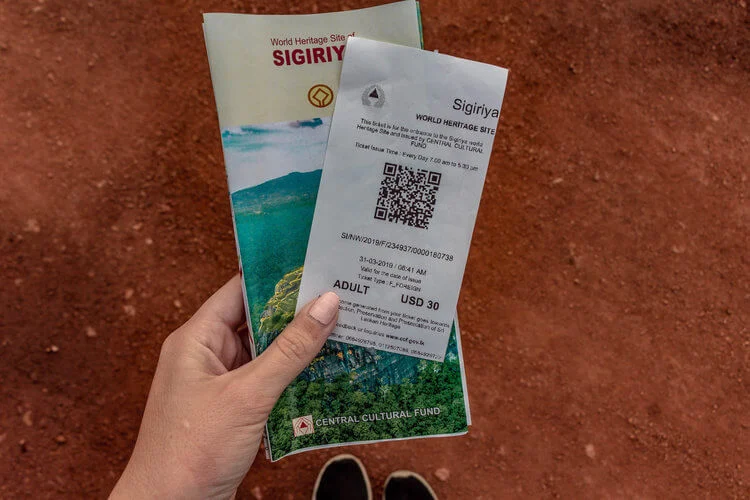
And better to arrive early in the morning before 09.00 am or late in the afternoon as it may be hard to climb during noon due to the high solar heat (only in some of the months)
Who can visit Sigiriya?
There are categories of people who can visit Sigiriya Lion Rock. And they are adults ages 12 and above; children ages 6 to 12; and toddlers below the age of 6.
Sigiriya ticket prices
The ticket for Sigiriya Lion Rock costs about $30 USD per person, which includes the ticket to the Sigiriya Lion Rock Museum. You can also buy a separate ticket to only visit the Sigiriya Museum. For locals, adults need to pay 100 LKR and children 50 LKR.
online tickets
The Sri Lanka Government Central Fund website now facilitates a service to buy tickets online for Sigiriya and surrounding highlights. So, don’t worry; you can complete the process at your leisure.
For more information, refer to this link. https://sigiriyafortress.com/sigiriya-opening-hours-sigiriya-ticket-prices/
Best time to Visit Sigiriya
The best time to visit Sigiriya is in the dry season, which lasts from late December to early April. And March is the best month for visibility and weather.
However, this is also the hottest time of the year, with hot and muggy weather. Therefore, bring as much water as possible, and don’t forget a hat and sunscreen. Also bear in mind that, as it is also prime travel time, considerable crowds should be expected. So, go for a sunset watch as the sunrise is probably impossible due to the ticket office opening. This will keep you from overcrowding and help you beat the heat. And yeah, you can definitely visit Pidurangala for the best view at sunrise. Now you won’t miss the sunrise and sunset. Happy days!
How to get to Sigiriya
It’s recommended that you choose to travel from Dambulla to Sigiriya to save time and money. But there are other routes, such as those from Kandy and from Colombo, too.
Things to know before you visit
01. Fitness to be concerned
We guarantee that even the fittest among you will find the ascent to the top of Sigiriya Rock Fortress to be a hot, occasionally breathless journey. It is a rather difficult hour-long stair climb in pretty oppressive heat and humidity.
Be ready by being aware of your boundaries, drinking plenty of water, and having sunglasses, sunscreen, and a hat on hand.
It may be a difficult trek for those who are afraid of heights, but it’s really safe and well worth it in our opinion.
02. Accessibility issues
The steep stair climb, which takes about an hour, is the only method to reach the top of Sigiriya. Unfortunately, to put it briefly, it’s not very accessible.
Unfortunately, you might have to skip this location if you have mobility or climbing concerns.
Fortunately, you could still explore the stronghold’s grounds, and there are still a lot of places to get a ground-level perspective of the rock fortress.
03. Photographical signs to be pointed out
In several locations throughout the Sigiriya climb, particularly along the fresco wall, photography is actually prohibited. Please don’t ignore the notices; they are very difficult to overlook and are intended to help with the protection and preservation of the thousands-year-old rock paintings.
The management is now very severe about this regulation and has been known to take away cameras (without giving them back) if you break them.
04. Not disturbing the Sigiriya wasps
You’ll see warning notices concerning wasps as you stroll through the Sigiriya gardens; these should not be disregarded! Large wasp nests can be found all around the grounds and in the rock walls, and sadly, a few attacks occur each year as a result.
There is supposedly a widespread belief in the area that they are truly King Kashyapa’s reborn soldiers, returning to secure his fortress. Whether you agree with this or not, the best approach to preventing getting stung is to walk very gently and avoid making rude movements, especially near the stairs. Visitors may also use the protective mesh cages available to them in case of a wasp assault.
What you can see in Sigiriya
01. Sigiriya Museum
Your entrance to the Sigiriya Museum is really included in the cost of your ticket, so it’s worthwhile to stop by to learn more about Sigiriya and its extensive and fascinating history.
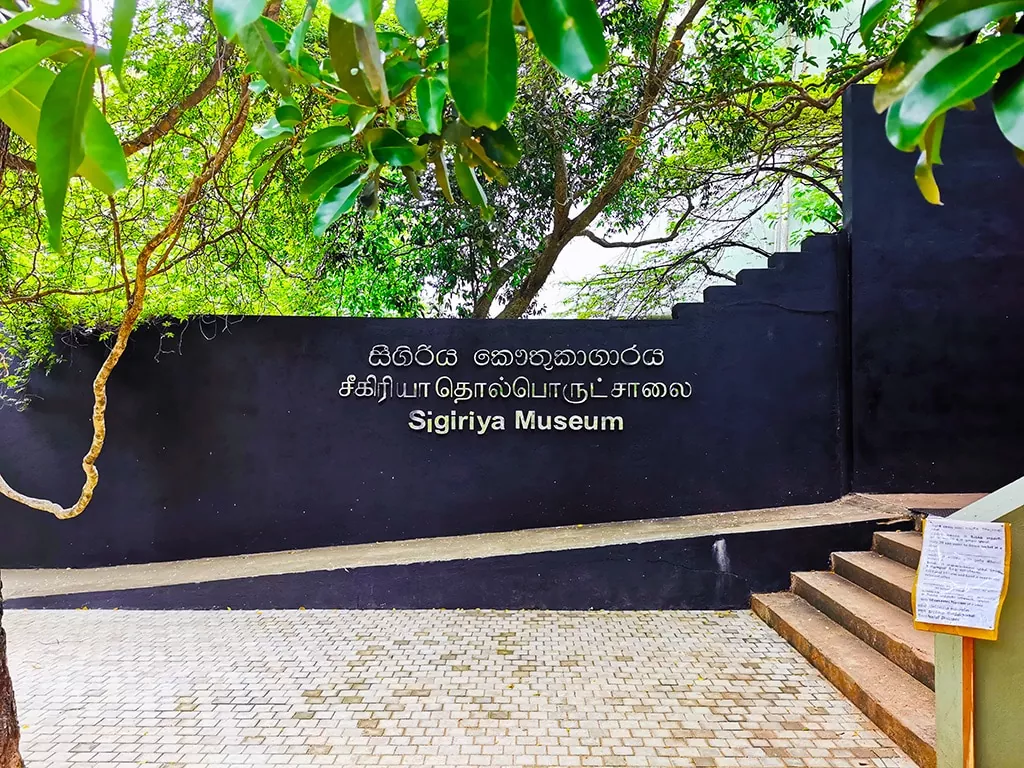
The museum features a sizable 3-D model of Sigiriya Rock, explanations of early (and extremely valuable) trade routes with the rest of the world, and a ton of images from the early excavations conducted by British archaeologist HCP Bell, who excavated numerous cultural sites in Sri Lanka in the late 19th century.
Photography is not permitted within the Sigiriya Museum.
02. The Royal Gardens
The gorgeous former royal gardens that surround the Rock Fortress, which draw the majority of visitors to Sigiriya, are also well worth your time.
The lush grounds are filled with adorned natural stones, charming terraced gardens, and stunning water fountains and sculptures. They were created using extremely cutting-edge technology at the time and are among the oldest manicured urban gardens in the world.
03. The Water Gardens
The water gardens are the first area you encounter as you enter the Sigiriya complex. They are a symmetrical collection of attractive pools and water features, former bathing lagoons, and island pavilions that are nourished by an advanced system of underground ducts and hydraulics that, at the time, was an engineering marvel.
04. The Boulder Gardens
The Boulder Gardens are much more in the vein of the “Angkor Wat jungle temple,” with narrow winding paths that twist through and past a series of ancient natural boulders, in contrast to the Water Gardens, which have the classic beauty and symmetry you’d also expect to see at any former royal palace in Europe.
The monastery that the monks of Sigiriya formerly called home was built upon these stones, and at one point in time, their surfaces would have been adorned with Buddha relics and shrines.
The walls, caves, and rock shelves still bear numerous traces of the former monastic existence.
05. The Frescoes / Sigiriya damsels
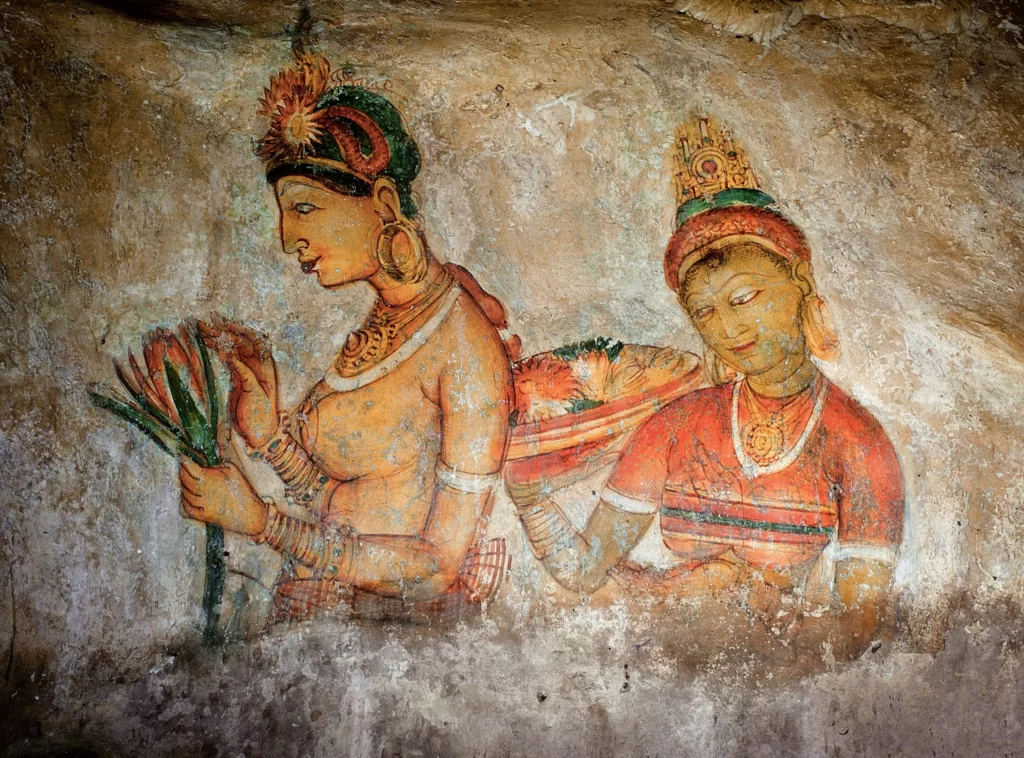
One of Sigiriya’s most well-known and acclaimed attractions is the frescoed wall. This depicts the so-called “Sigiriya Damsels”—21 stunning, barely clothed women with quite large bosoms who give fruit platters or flower petals.
Apsaras (celestial nymphs), King Kasyapa’s concubines, or even Tara, a significant character in Tantric Buddhism, are some of the theories put forth for the identities of women. The visuals are still breathtakingly brilliant and fascinating to look at since they are shielded from the elements by the overhanging rock.
Since flash photography is extremely harmful and prior tourists ignored instructions not to use it, photography is prohibited here to protect the damsels. So don’t risk it
06. The Mirror Wall
The mirror wall used to be considered to be so polished that the King could see his own reflection in the stone, but it is now much less shiny.
This does not imply that it is unimportant, however, as it is covered in the scrawls of old graffiti left by the visitors to Sigiriya over the course of 1500 years. These graffiti include poems, visitor impressions, and tributes that date as far back as the 7th century.
Note: Today, visitors are not permitted to spray-paint their own tributes because of the historical value of some of this graffiti. Respect this by refraining from making your own marks on the walls (nor on any culturally significant structure around the world)
07. Lion Paw Staircase
Two giant lion paws that stand guard at the top of a winding staircase are what give Sigiriya its nickname, “Lion Rock.” Once upon a time, one could have climbed up from these paws and into the gaping mouth of the lion using the stairs from the fifth century.
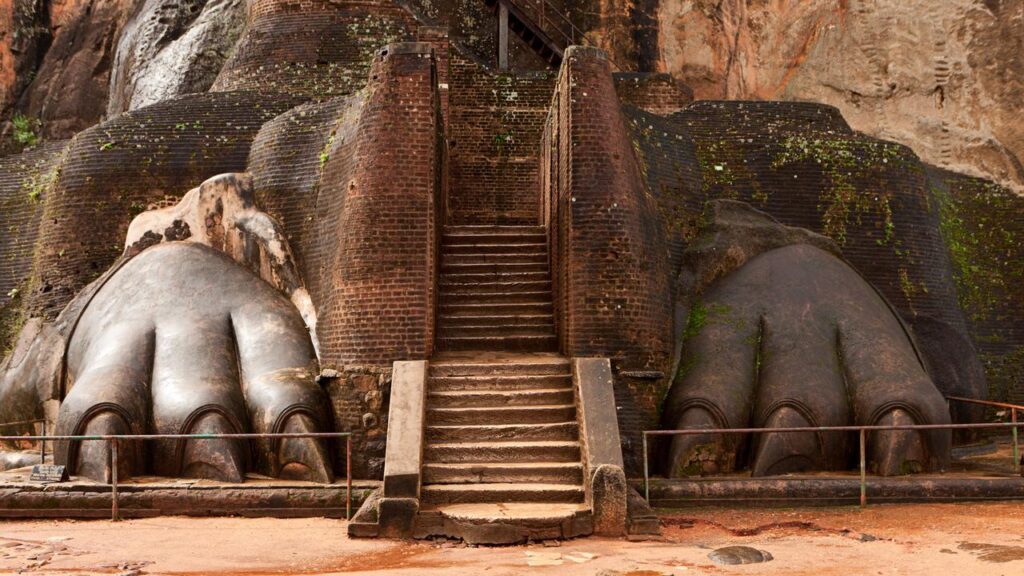
Buddhist followers were supposed to be reminded symbolically by ascending through the mouth of the lion that Buddha was Sakya-Sinha or the Lion of the Sakya Clan and that his truth was as potent as a lion’s roar.
These paws and the first set of stairs are all that remains of the lion’s head, though you can clearly make out where the various construction grooves or pegs were along the way.
08. Sigiriya Summit
For those with a fear of heights, the last ascent of the Sigiriya summit, up the slender metal ladder that appears to be perilously nailed into the rock face, can be a little nerve-wracking. However, the vistas over the emerald canopy below are totally worth it once you step out into the fortress summit’s open expanse.
King Kasyapa’s fortified palace’s ruins are dispersed around this area, albeit they have been reduced to nothing more than foundations and aren’t particularly interesting to roam around.
The views are what you’re here for, and with Pidurangala in the distance and thick vegetation covering the plains below as far as the eye can see, visiting the Dambulla Rock Cave Temple, going on an elephant safari at the Kaudulla National Park, and all of this, it’s an incredible sight that justifies continuing your climb up the Rock fortress.

